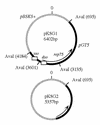Topoisomerase activity of the hyperthermophilic replication initiator protein Rep75
- PMID: 10871346
- PMCID: PMC102634
- DOI: 10.1093/nar/28.11.2251
Topoisomerase activity of the hyperthermophilic replication initiator protein Rep75
Abstract
The plasmid pGT5 from the hyperthermophilic archaeon Pyrococcus abyssi replicates via the rolling circle mechanism. pGT5 encodes the replication initiator protein Rep75 that exhibits a nicking-closing (NC) activity in vitro on single-stranded oligonucleotides containing the pGT5 double-stranded origin (dso) sequence. Some mesophilic Rep proteins present site-specific DNA topo-isomerase-like activity on a negatively supercoiled plasmid harbouring the dso. We report here that Rep75 also exhibits topoisomerase activity on a negatively supercoiled DNA substrate. This DNA topoisomerase-like activity is dependent on the amino acids involved in NC activity of Rep75. However, in contrast with mesophilic Rep proteins, Rep75 topoisomerase activity is not dso dependent. Moreover, although pGT5 is known to be relaxed in vivo, Rep75 was not able to act on a relaxed plasmid in vitro, whether or not it contained the dso.
Figures






Similar articles
-
The active site of the rolling circle replication protein Rep75 is involved in site-specific nuclease, ligase and nucleotidyl transferase activities.Mol Microbiol. 1999 Aug;33(3):537-45. doi: 10.1046/j.1365-2958.1999.01498.x. Mol Microbiol. 1999. PMID: 10417644
-
A rolling circle replication initiator protein with a nucleotidyl-transferase activity encoded by the plasmid pGT5 from the hyperthermophilic archaeon Pyrococcus abyssi.Mol Microbiol. 1998 Mar;27(6):1183-92. doi: 10.1046/j.1365-2958.1998.00759.x. Mol Microbiol. 1998. PMID: 9570403
-
pGT5 replication initiator protein Rep75 from Pyrococcus abyssi.Methods Enzymol. 2001;334:193-204. doi: 10.1016/s0076-6879(01)34468-3. Methods Enzymol. 2001. PMID: 11398461 No abstract available.
-
The unique DNA topology and DNA topoisomerases of hyperthermophilic archaea.FEMS Microbiol Rev. 1996 May;18(2-3):237-48. doi: 10.1111/j.1574-6976.1996.tb00240.x. FEMS Microbiol Rev. 1996. PMID: 8639331 Review.
-
Reverse gyrase: an unusual DNA manipulator of hyperthermophilic organisms.Ital J Biochem. 2007 Jun;56(2):103-9. Ital J Biochem. 2007. PMID: 17722650 Review.
Cited by
-
Phylogenomics of DNA topoisomerases: their origin and putative roles in the emergence of modern organisms.Nucleic Acids Res. 2009 Feb;37(3):679-92. doi: 10.1093/nar/gkp032. Epub 2009 Feb 9. Nucleic Acids Res. 2009. PMID: 19208647 Free PMC article. Review.
-
Four different integrative recombination events involved in the mobilization of the gonococcal 5.2 kb beta-lactamase plasmid pSJ5.2 in Escherichia coli.Plasmid. 2008 Nov;60(3):200-11. doi: 10.1016/j.plasmid.2008.07.004. Epub 2008 Sep 26. Plasmid. 2008. PMID: 18778732 Free PMC article.
-
Archaeal extrachromosomal genetic elements.Microbiol Mol Biol Rev. 2015 Mar;79(1):117-52. doi: 10.1128/MMBR.00042-14. Microbiol Mol Biol Rev. 2015. PMID: 25694123 Free PMC article. Review.
-
Precise determination, cross-recognition, and functional analysis of the double-strand origins of the rolling-circle replication plasmids in haloarchaea.J Bacteriol. 2008 Aug;190(16):5710-9. doi: 10.1128/JB.00596-08. Epub 2008 Jun 20. J Bacteriol. 2008. PMID: 18567665 Free PMC article.
References
Publication types
MeSH terms
Substances
LinkOut - more resources
Full Text Sources

